






 |
 |
 |
 |
 |
 |
 |
Laufhunde - Meutehunde - Bracken > Menü Jagd & Jäger |
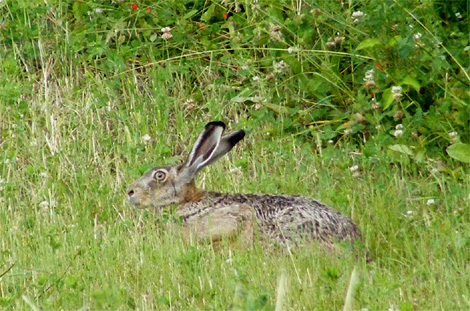 |
Hare hunting with Italian Segugios in Italy In most Italian regions the hunting season starts on the third sunday of september at first light. |
Well trained Segugios wait for their master's signal to start the hunt.
Searching for the hare's night trail.
Youngster astray? |
Though every hound
is expected to search the meadow independently for the cold scent left by the hare during his nightly pasture, experienced pack members tend to work not too far from each other and always keep contact with the master, while high-spirited youngsters might rush off 150-200 meters, often missing what they are smelling for, as they still lack the calm expertise the others have acquired through the years. Therefore it's unlikely that a young hound will give the first cry of triumph to let the others know of his success. He might give voice exitedly, yes, but just to realise a second later that he's on the wrong track... Masters frown upon this kind of behaviour because allthough a Segugio must, of course, inform master and pack about finding a promising night trail, he's not supposed to be "chatty", much less confuse his companions with useless "talk". In the unfortunate case that the pack doesn't encounter any scent in the course of 10-15 minutes, the master moves them to the next field near by and encourages them to try again. Once a pack member has truely found a fresh enough trail, the second phase called "accostamento" in Italian, that is "approach", begins as the pack can now approach the hare in his den by working along his exit trail. Of course, it takes a good nose to actually follow the scent leading off the pasture among the jumble of olfactory traces produced by the feeding hare. Therefore the hounds are allowed to search autonomously as long as they keep in touch with each other, and it's quite alright if a single, well experienced hound moves ahead to scan the meadow's edge for the trail's exit all by himself, as he will only give voice when he has really found the fresh scent and, most importantly, the other members of the pack will trust him and follow his lead. Thus the hound who finds the exit trail will give voice clearly, his companions will hurry by his side and follow in his wake, because now the pack has to unite again, and should the group include several hounds equally qualified they are supposed to take turns in leading their companions forward. Until... |
The pack follow their trusted leader. |
...Until they meet with the first "fallo" or loss of trail. At this point every single member of the pack is asked to find the solution in his own way. One might search meticulously around the spot where they lost the scent, another might investigate much further off, but never will anyone get too far from their olfactory "point of reference". While the hounds try to tie up again with the lost trail, there is no useless seesaw, no futile "talk", passion, yes, but noisy overzeal, never. During this second phase of the hunt each hound can and should prove the efficiency of his olfaction, his competence and certainty in evaluating the trail and refinding it when lost and last but not least demonstrate his team spirit. Even if the master were not to see his pack during the approach phase, he would know for sure which hound gave a vocal signal and exactely what it means. It's really fascinating to watch a master reacting correctly just by listening to his pack. He can tell by the sound of every single voice if the hound is sure of the scent he's following or if he's beginning to doubt it, if he has lost the trail for good or if he's just quietly and confidently looking for the continuation of the olfactory thread, if he has changed over to another, fresher scent, or, God forbid, left the hare's track to chase a roe deer instead. (But normally young hounds learn well enough during their training that there is only one game for them: the hare and only the hare.) How long and difficult it's going to be for the pack to reach the hare's den depends, obviously, on numerous factors, such as air humidity, wind, vegetation, dryness or moistness of the ground, structure of the landscape itself and so on. And if it's hard for the hounds, it's worse still for the master who, during the initial part of the hunt, will always stay as near as possible to the pack without disturbing them, and that means speeding up and down the hillside afoot, through bushes and thorns, through uncultivated deciduous forest and streams. In a territory like ours (the highland of Pavia, northern Italy), where the wooded hills are cut by an infinity of tiny valleys, the huntsmen surrounding the area often loose acustical contact with the pack and have to change their position according to the instructions given by the master via walkie-talkie. More often than not everybody has to move around several times to be in the right place for the moment the hare will start to run. |
Just listen and you will know....
The master stays near his hounds until they finally force the hare to take flight.
|
The prelude to that exiting moment is called "lo scovo" or "flushing" and is the third phase of a Segugio's work. Arriving in the vicinity of the den every member of the pack should show clearly that he is scenting the prey nearby and is absolutely determined to flush the hare, though every individual might express this differently: some hounds just seem very tense all of a sudden, some communicate their state of mind by a particular timbre of their voice, others by an attentive posture, and these outwards signs, especially the voices, tell the master that his pack is to force the hare out in the open any moment now. A true houndsman would never shoot a passing hare without his pack having worked it properly before. After all, the fascination of hare hunting with Segugios lies precisely in this opportunity to follow and watch the hounds work most of the time, to appreciate each members qualities or progress, to check on their team work, to see small mistakes that will have to be straightend out by more training or practise in the field. If the hounds are experienced and work well together they might reach the hare's den in 5-15 minutes, and while up til then they only gave voice occasionally and for good reason, now is the time to let hare, master and huntsmen know they're coming! The fourth and last phase of the hunt, "la seguita" or the chase is accompanied by the beautiful sound of their voices echoing through the woods, loud and clear, and again the master will listen... |
Individual talent as well as team spirit is expected from a typical Segugio.
The chase is on.
|
The hare is perhaps the smartest and most versatile game when it comes to outwitting his persuers, thus the pack must hassle him and force him to hurry ahead, follow him with complete confidence and reliabilty, giving voice all the way. Indeed, the voice, it's expressiveness, rhythmical frequence, timbre and sound are of the greatest importance to master and huntsmen now. No deviations are allowed at this point, no useless rushing around, no unwarranted return to a previously worked out part of the trail. Persistency and deliberateness, speed in proper relation to olfactory capacity is what it needs. And allthough the Segugio is very fast, for him the pursuit is, in fact, not about speed. These hounds are trained in difficult territories on purpose so that they may learn to use all their physical and mental resources and to tap their full potential while hunting. The pack has to stick together during the chase, but again each individual must show his security, persistency and initiative as well as his capacity to cooperate perfectly with the rest of the group. During the chase there is just one excuse for the hounds to stop and that are natural obstacles, and just one excuse for the pack to temporarily loose the trail and that is the hare's enormous cunning. But unlike in the second phase this time the hounds are expected to refind the scent very fast. To do that they need intelligence, the capability to concentrate on the problem at hand, calm and determination, in other words: their grey matter has to help their olfaction. What a master surely doesn't want to see instead is stubbornness. An obstinate hound always tends to get wound up in a lost trail for much too long, loosing time and energy for nothing, especially when the master is not around to help, and puzzling over a lost scent for hours is simply unintelligent. A wise hound who even after 30 minutes hasn't been able to solve the problem will return to his master. |
The intelligent hound turns to his master if he can't solve a problem himself.
Well done! |
So, a chase can take 10 minutes or an hour, but it's final outcome depends not on the pack but on the huntsmen. Many a hare has broken through the lines because, well, the shooters simply missed, to their own embarrassment and the discontent of the master who has to put the pack on the same old trail again... But if all goes well the pack will reach the spot where the hare fell quite a while after his death. Of course they're welcome to sniff at the prey and the young hounds might try to tug at the dead animal, but generally they loose interest rather soon, much keener on being sent to work once more. As hare hunters pack up around midday at the latest, the hounds may be lucky enough to get a second or even a third chase, and when they finally jump back into the boxes in the SUV they have that aura of "dogly" satisfaction about them and you simply feel that after a well deserved rest in the kennel, next morning they will get off the truck with fresh enthusiasm, and I'm sure, if it were up to them, the hare hunting season would last all year! |
Off to the second chase!
Time to pack it for today.
|
Now, true Segugio Italiano fans agree that allthough these hounds usually work in packs, sometimes as pairs but rarely as singles, every individual should be a "complete" hound, meaning that he or she should be able to do the four phases of a hare hunt successfully and according to the specific style of the breed. The reasoning behind this demand is obvious: even an utterly untalented hound without personality can appear to be good (at least to the untrained or unwilling eye) by simply following the pack. If many such apparently well doing animals are later used for reproduction, they might, on the long run, diminish the quality of the breed. In every hound breed used to work in packs there is the occasional specialist, the one who, in the case of the Segugio, excells in finding and following the night trail, or the one who brilliantly leads the pack towards the hare's den, yet another has the skill to force his prey out of hiding or to refind the lost track while chasing the hare. Naturally, talents like that are welcome, as long as they do not hide the simple fact that the hound in question isn't good for anything else... So, the Segugio must be, first and foremost, a complete hound, specialization comes only second place. |
A really good Segugio must be a "complete" hound.
|
| Photos 1-9, 12-16, 18-22: Sabine Middelhaufe; 10-11: Stefan Mähler: 17: Engelbert Braun. Text (c) 2010 |
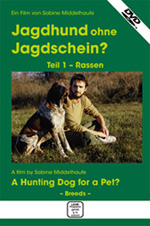 |
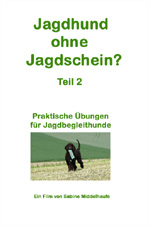 |
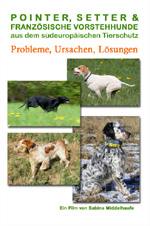 |
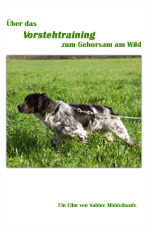 |
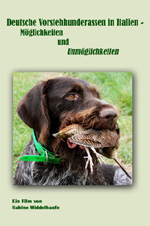 |
| home | Seitenanfang | Menü Fotoalbum |